Coordinators:
Amar Ayyash (US)
Bruce Mactavish (Canada)
Dave Brown (Canada)
Mars Muusse (Netherlands)
smith rings
smith PDF's
smith 1cy August
smith 1cy September
smith 1cy October
smith 1cy November
smith 1cy December
smith 2cy January
smith 2cy February
smith 2cy March
smith 2cy April
smith 2cy May
smith 2cy June
smith 2cy July
smith 2cy August
smith 2cy September
smith 2cy October
smith 2cy November
smith 2cy December
smith 3cy January
smith 3cy February
smith 3cy March
smith 3cy April
smith 3cy May
smith 3cy June
smith 3cy July
smith 3cy August
smith 3cy September
smith 3cy October
smith 3cy November
smith 3cy December
smith sub-ad January
smith sub-ad February
smith sub-ad March
smith sub-ad April
smith sub-ad May
smith sub-ad June
smith sub-ad July
smith sub-ad August
smith sub-ad September
smith sub-ad October
smith sub-ad November
smith sub-ad December
smith ad January
smith ad February
smith ad March
smith ad April
smith ad May
smith ad June
smith ad July
smith ad August
smith ad September
smith ad October
smith ad November
smith ad December
|
American Herring Gull 4cy July
The Peterson Reference Guides
GULLS OF THE AMERICAS
- Steve N.G. Howell / Jon Dunn -
Below is a copy of chapter 25 about American Herring Gull, illustrated with images from this website. "we" in the text below refers to the original authors.
If any errors occur in this text, please let me know and mail to marsmuusseatgmaildotcom.
American Herring Gull (smithsonianus)
PART 1: IDENTIFICATION SUMMARY
PART 2: FIELD IDENTIFICATION - ADULT CYCLE
PART 3: FIELD IDENTIFICATION - FIRST CYCLE
PART 4: FIELD IDENTIFICATION - SECOND & THIRD CYCLE
PART 5: RARER SPECIES
PART 6: DESCRIPTION & MOLT IN ADULT CYCLE
PART 7: DESCRIPTION & MOLT IN FIRST & SECOND CYCLE (BELOW)
DESCRIPTION & MOLT
First Cycle.
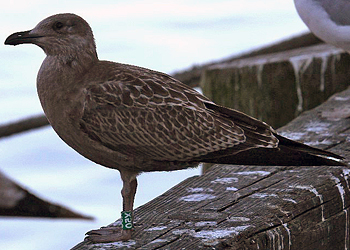 |
 |
American Herring Gull (smithsonianus) juvenile X50 August 30 2012, Gloucester, MA (Keith Mueller). Juvenile fresh dark plumage, but already single feathers in upper scapulars seem to be missing. Note overall dark brown aspect, bill size and shape, and dull pinkish on bill base. |
American Herring Gull (smithsonianus) 1st cycle, October 08 2006, Newfoundland (Bruce Mactavish). Juvenile plumage, no scaps replaced by early-Ocober. Scapular tips start to show a first sign of wear and upperpart edgings have bleached to whitish. Note the pale base of the bill, uniform under-parts and neck, dark tail, bold pattern on undertail-coverts. Thin white fringes on primary tips. |
 |
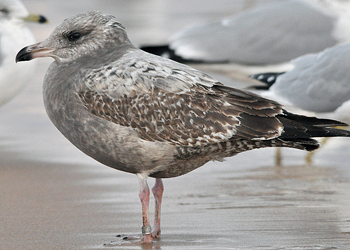 |
American Herring Gull juvenile, December 10 2013, Half Moon Bay, CA (Alvaro Jaramillo). Bi-coloured bill, juvenile plumage by December. |
American Herring Gull (smithsonianus) 1st cycle 1106-13848 December 07 2013, New Buffalo, MI (Amar Ayyash). Banded June 2013 at Door County WI (44ºN). All scaps replaced. Much of brown aspect replaced in neck, side of breast and flanck, now cold greyish. |
 |
 |
American Herring Gull (smithsonianus) 1st cycle YK February 16 2012, Ontario (Brandon Holden). Banded September 2011 at Petty Harbour (47ºN). Only few scaps replaced, most of upperparts bleached and worn. |
American Herring Gull (smithsonianus) 1st cycle, December 02 2009, Lewiston, NY (Brad Carlson). All scapulars replaced. Note 2nd gen GC2 and probably also 1x LLC. Paler and greyer bird with sparser dark barring. Pinkish base of bill. |
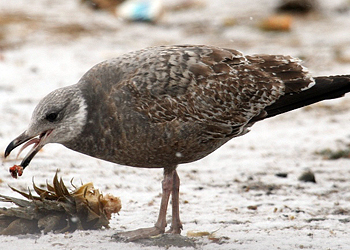 |
 |
American Herring Gull (smithsonianus) 1st cycle, February 09 2008, Dryden, NY (Mike). Brown aspect. Fresh feathers (grey) on hindneck, side of the neck and flank. Crown and ear-coverts replaced as well, throat worn whitish 1st gen feathers. Pale bill base. |
American Herring Gull (smithsonianus) 1st cycle, April 17 2012, Gloucester, MA (Keith Mueller). Lowest row of scapulars still juvenile, old and abraded. Note fresh feathers in side of the neck and side of the breast, replaced recently and obviously grey, contrasting with warmer brown old feathers. |
 |
 |
| American Herring Gull (smithsonianus) 1st cycle, March 02 2013, Circle Beach, CT (Keith Mueller). Limited scapular moult. Spending winter at 41ºN, still brown aspect by March. |
American Herring Gull (smithsonianus) 1st cycle, March 19 2009, Aransas Pass, TX (Tripp Davenport). Spending winter at 27ºN in Texas, leaving strongly bleached plumage. |
First Cycle.
Juvenile (Aug.-Feb.): dark brown to medium gray-brown overall. Head, neck, and underparts variably streaked and mottled whitish, becoming whitish on vent and undertail coverts, which have broad, sooty brown bars. Upperparts with buff (bleaching to dull whitish) scaly and notched edgings and markings, the outer greater coverts often with unmarked (or lightly marked) bases. Upperpart markings typically scaly to checkered, often fairly contrasting and neatly marked in fresh plumage (through late winter on some birds). Tertials darker, blackish brown with notched whitish tips and distal edging. Uppertail coverts whitish with strong dark barring. Flight feathers black to brownish black, secondaries and tail narrowly tipped whitish, outer primaries with narrow whitish tips visible at rest (lost through wear). Pale panel on inner primaries distinctive on spread wing but varies from strongly contrasting (usually) to poorly contrasting on some heavily pigmented birds; outer primaries blackish with paler edging to inner webs not reaching shaft. Tail variable: most East Coast types and some West Coast types have almost solidly blackish tail with limited whitish barring on inner webs of outer rectrices (rarely visible) and whitish ribbing on outer web of R6. (Howell pers. obs.) Many West Coast types and some East Coast types have extensive whitish barring on tail base (mainly on inner webs) so tail has a blackish distal band (best seen from below or with tail fully spread). (Howell pers. obs.)
 |
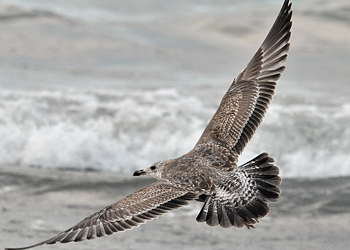 |
American Herring Gull (smithsonianus) 1st cycle 1106-13848 December 07 2013, New Buffalo, MI (Amar Ayyash). Banded June 2013 at Door County WI (44ºN). Note paler panel on inner primaries, poor contrast between outer and inner webs on blackish outer primaries, mostly blackish tail and note bill size and shape. |
American Herring Gull (smithsonianus) 1st cycle 1106-27465December 07 2013, New Buffalo, MI (Amar Ayyash). Banded June 2013 at Door County WI (44ºN). Note paler panel on inner primaries, poor contrast between outer and inner webs on blackish outer primaries, mostly blackish tail and note bill size and shape. |
 |
 |
American Herring Gull (smithsonianus) 1st cycle 1106-13848 December 07 2013, New Buffalo, MI (Amar Ayyash). Banded June 2013 at Milwaukee WI (43ºN). This is an example bird representing a very small minority that replace some wing-coverts and/or tertials in the post-juvenile moult; this bird has replaced GC1-2, MC1-2 in the left wing. Note paler panel on inner primaries, poor contrast between outer and inner webs on blackish outer primaries, mostly blackish tail and note bill size and shape. |
American Herring Gull (smithsonianus) 1st cycle, March 04 2012, Whiting, IN (Amar Ayyash). Note paler panel on inner primaries, poor contrast between outer and inner webs on blackish outer primaries. Almost translucent inner primaries and much white in outer rectrices (in some birds resulting in a broad blackish distal tail-band, best seen from below in spread tail). |
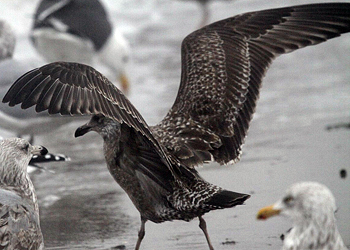 |
 |
| American Herring Gull (smithsonianus) 1st cycle, March 02 2013, Circle Beach, CT (Keith Mueller). Some dark pigmented birds have a poor contrasting paler window on the inner primaries. |
American Herring Gull (smithsonianus) 1st cycle, January 28 2010, Daytona Beach, FL (Reinhard Geisler). Extensively pale bases to the outer rectrices, so tail shows a broad blackish distal band. |
IN FLIGHT: dark brownish to gray-brown overall with blackish flight feathers except for pale inner primary panel, variable whitish barring at tail base; underwings medium to dark brown with inner primaries appearing as a paler panel when backlit; underside of primaries can look reflectively pale; tail coverts strongly barred whitish. Eyes dark, bill blackish with variable dull flesh on basal two-thirds, and by midwinter some birds have flesh pink bill with fairly clean-cut blackish tip; legs dusky flesh to flesh pink. PA1 molt (Sept.-May; exceptionally includes upperwing coverts) produces first alternate plumage: head, neck, chest, and flanks smoky gray-brown to sooty gray often mixed with bleached juvenal feathers and with variable whitish streaking and mottling; head often bleaches to whitish. A1 scapulars range from brownish gray to pale gray typically with a broad dark basal wedge or median band and often with a narrow dark subterminal band or anchor pattern; late-molted scapulars can be fairly plain grayish with fine dusky vermiculations or a dark shaft streak. A common pattern of first-winter birds is a grayish back with slightly checkered dark barring mixed with brown juvenal scapulars. In late winter, blackish to blackish brown wingtips and worn, dark brown tertials often contrast with worn and bleached upperwing covert panel. Bill dull flesh to flesh pink basally with black tip and sometimes a fine pale horn tip; legs flesh pink; eyes dark.
Second Cycle.
 |
 |
American Herring Gull (smithsonianus) 2nd cycle in PB2 moult, August 04 2012, Maine (Dominic Mitchell). Note overall brown aspect, bill size and shape. Active moult in central primaries. P10 still old. |
American Herring Gull (smithsonianus) 2nd cycle in PB2 moult R23 September 13 2013, Hampton Beach, NH (Jon Worthen). Banded in 2012. P8 fully grown, no old juvenile outer primaries left. Overall grey-brown. |
 |
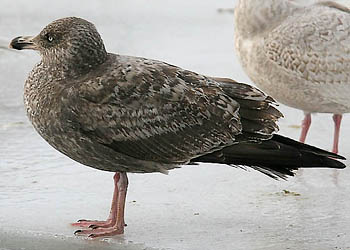 |
American Herring Gull 2nd cycle, December 12 2013, Tompkins Co, NY (Kevin McGowan). 2nd gen flight feathers, and most coverts also 2nd gen. Still no grey scaps. Limited partial autumn moult, 3rd gen coverts much 2nd gen-like patterned. Note pale eye. |
American Herring Gull (smithsonianus) 2nd cycle, February 07 2005, Newfoundland (Jeff Poklen).Bold 'smoky' winter streaking concentrated in the hindneck, but also on flanks and underparts. Obvious greater covert bar. Note replaced upper tertials and greater covert #2 (from partrial autumn moult), and note pale iris. From a European perspective probably 'the most rewarding' type of bird to look for. |
 |
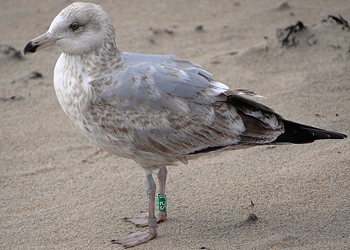 |
| American Herring Gull (smithsonianus) 2nd cycle T20 March 04 2012, Hampton beach, NH (Keith Mueller). Banded in 2010. Distinguished from 1st cycle by more-rounded primaries, finer speckling on GC's, brightly bi-coloured bill, and incoming clear grey in scapulars. Still has a dark eye. |
American Herring Gull (smithsonianus) 2nd cycle L52 April 13 2013, Hampton beach, NH (Jon Woolf). Banded in 2011. A relatively "advanced" individual, but note 2nd generation flight feathers (pattern on lower TT and especially dark centres of secondaries just visible beneath GC's). |
 |
 |
American Herring Gull (smithsonianus) 2nd cycle P02 March 05 2012, NH Coast. Picture: Keith Mueller. Banded July 15 2010. Classic 2nd cycle plumage with pale panel on inner primaries, and mostly dark outer primaries. |
American Herring Gull (smithsonianus) 2nd cycle, December 08 2012, Lake County, IL (Amar Ayyash). Classic 2nd cycle plumage with pale panel on inner primaries, and mostly dark outer primaries, mostly black tail and pale eye. |
 |
 |
American Herring Gull (smithsonianus) 2nd cycle, November 26 2011, Moncton, NB (P.J. Gergely). Note 2nd gen pattern on inner primaries, brightly bi-coloured bill and pale iris. |
American Herring Gull (smithsonianus) 2nd cycle, March 04 2012, Whiting, IN (Amar Ayyash). Some upper TT and MC replaced in partial autumn moult. Contrasting pale panel on inner primaries and mostly black tail. |
Second Cycle.
Complete PB2 molt (Apr./May-late Sept./Nov.) into second basic plumage. Some birds bleach strikingly by early summer, before PB2 is very advanced, and new B2 feathers can look contrastingly dark. Mottled brown and pale brown overall with variable whitish streaking and mottling on head, neck, and underparts; undertail with variable brown barring and mottling, less neat than first-cycle barring; some birds have scattered gray on back; uppertail coverts mostly white with sparse dark markings; head and chest of some birds bleach by midwinter. Relative to first cycle, greater coverts and blackish brown tertials typically have finer, more-peppered whitish distal markings; median and lesser coverts often more coarsely barred. Flight feathers similar to first cycle but wingtips and tail often blacker; inner primaries average grayer and more contrasting, rarely with 1-2 broadly white-tipped feathers; wingtips with narrow whitish tips and, very rarely, a small, diffuse P10 mirror; outer rectrices with white basal corners more streaked, less barred than first cycle. Wing-linings medium brown to whitish with fairly heavy brown mottling. Eyes brownish to pale lemon, bill typically flesh pink with black distal third and pale horn tip (sometimes dull, like first winter), legs flesh pink. Partial PA2 molt (Sept.-Apr./May; often includes some upperwing coverts) produces second alternate plumage: head, neck, and underparts white, mottled and streaked dusky (sometimes bleaching and wearing to mostly white by summer), back can become mostly pale gray in contrast to faded upperwing coverts; some birds attain a few gray upperwing coverts, especially median coverts. Eyes pale lemon to brownish, orbital ring can be yellow-orange in summer. Through winter, bill typically pinkish basally, blackish distally with pale tip and sometimes a blush of reddish at gonys; in summer, some birds have yellowish bill with reddish gonydeal smudge and black distal band. Legs flesh pink.
CONTINUE PART 8: DESCRIPTION & MOLT IN THIRD CYCLE AND HYBRIDS |
banded birds |
 American Herring Gull (smithsonianus)
American Herring Gull (smithsonianus) American Herring Gull (smithsonianus) Q Q Q Q Fed band Q sub-adult, July 05 2012, Cornwall Dam, Ontario. Picture: Dean Spic.
American Herring Gull (smithsonianus) Q Q Q Q Fed band Q sub-adult, July 05 2012, Cornwall Dam, Ontario. Picture: Dean Spic. American Herring Gull (smithsonianus) X44 4th pre-basic moult (4CY), July 25 2015, Race Point, Provincetown, Barnstable County, Massachusetts. Picture: Steve Arena.
American Herring Gull (smithsonianus) X44 4th pre-basic moult (4CY), July 25 2015, Race Point, Provincetown, Barnstable County, Massachusetts. Picture: Steve Arena. American Herring Gull (smithsonianus) sub-adult, July 25 2012, Vinalhaven, ME., US. Picture: Keith Mueller.
American Herring Gull (smithsonianus) sub-adult, July 25 2012, Vinalhaven, ME., US. Picture: Keith Mueller. American Herring Gull (smithsonianus) 4cy, July 11 2009, Jamestown, Rhode Island, US. Picture: Elliot Gilfix.
American Herring Gull (smithsonianus) 4cy, July 11 2009, Jamestown, Rhode Island, US. Picture: Elliot Gilfix. American Herring Gull (smithsonianus) sub-adult, July 09 2009, Chester Basin, Nova Scotia, Canada. Picture: Maxine Quinton.
American Herring Gull (smithsonianus) sub-adult, July 09 2009, Chester Basin, Nova Scotia, Canada. Picture: Maxine Quinton.
























